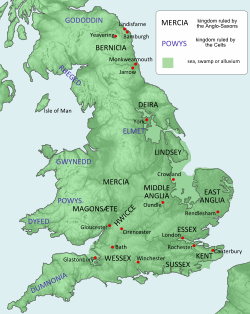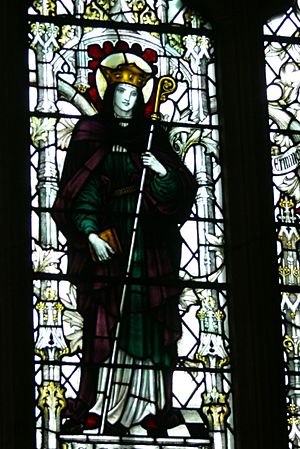Seaxburh of Ely facts for kids
Quick facts for kids Saint Seaxburh |
|
|---|---|

A mediaeval painting of the translation of Æthelthryth at Ely, attended by her sister Seaxburh
|
|
| Queen consort of Kent | |
| Born | early 7th century |
| Died | 6 July 699 Ely |
| Venerated in | Catholic Church; Eastern Orthodox Church, Anglican Communion |
| Canonized | Pre-Congregation |
| Feast | 6 July; 17 October (translation) |
Seaxburh (died around 699) was a powerful queen and a respected abbess. She is also known as Saint Sexburga of Ely. She was an important figure in early Christianity in England. Seaxburh was married to King Eorcenberht of Kent.
After her husband died in 664, Seaxburh stayed in Kent. She raised her children there. She also acted as a regent (a ruler for a young king) until her son Ecgberht was old enough to rule.
Seaxburh started two important religious places called abbeys. These were at Milton Regis and Minster-in-Sheppey. Her daughter Ermenilda became a nun at Minster-in-Sheppey. Later, Seaxburh moved to a special monastery in Ely. Her sister Æthelthryth was the leader (abbess) there. When Æthelthryth died in 679, Seaxburh became the new abbess.
In 695, Seaxburh moved her sister Æthelthryth's body to a new tomb. This was 16 years after Æthelthryth had died. When they opened the grave, they found her body was still perfectly preserved. This was seen as a miracle. The story is told by a writer named Bede in his book, Ecclesiastical History of the English People.
Seaxburh's Family
Seaxburh was the daughter of Anna. He was the King of East Anglia. King Anna ruled in the early 640s. He died in a battle around 653 or 654.
Seaxburh married Eorcenberht of Kent. He was the king of Kent from 640 to 664. Together, they had two sons and two daughters. Both of their sons became kings of Kent. These were Ecgberht and Hlothhere. Their daughters were Eormenhild and Ercengota. Both daughters later became saints.
Seaxburh had several sisters. These included Æthelburg of Faremoutiers, Saethryth, and Æthelthryth. Æthelburg and Saethryth were both abbesses at a place called Faremoutiers Abbey. Her sister Æthelthryth also became a famous saint.
Seaxburh was buried at Ely. Her sisters Æthelthryth and Wihtburh were also buried there. Her daughter Eormenhild was buried with them too.
Queen and Regent

Seaxburh became queen when she married Eorcenberht. He was king of Kent. Their sons, Ecgberht and Hlothhere, both became kings later. Their daughter Ercongota became a nun and was made a saint.
The Anglo-Saxon Chronicle mentions King Eorcenberht. It says he was the first English king to make Easter a special festival. The Chronicle also mentions Seaxburh and her daughter Eorcengota. It calls Eorcengota "a holy and a remarkable person." It says her mother was Seaxburh, daughter of King Anna.
Seaxburh and Eorcenberht had another daughter, Ermenilda. She married Wulfhere of Mercia. After he died, Ermenilda became a nun and a saint. Seaxburh's marriage was important for women in religious life. She showed that a queen could become a nun.
King Eorcenberht died on July 14, 664. There was a terrible plague that year. After his death, Seaxburh stayed in Kent. She raised her children and had a big influence in the kingdom. She ruled Kent as a regent for her young son Ecgberht.
Seaxburh also started Kent's first abbey for women at Milton. Later, she became a nun herself. She then founded another abbey at Minster-in-Sheppey. A book from the 12th century, the Liber Eliensis, says that Theodore, the Archbishop of Canterbury, helped Seaxburh become a nun. Her daughter Eormenhild also became a nun there.
Life at Ely Monastery

Soon after, Seaxburh moved to a double monastery in Ely. This was a place for both monks and nuns. Her sister Æthelthryth was the abbess (leader) there.
Seaxburh became abbess when Æthelthryth died in 679. Seaxburh had experience ruling in Kent. This helped her lead the large monastery at Ely.
In 695, Seaxburh decided to move her sister Æthelthryth's body. Æthelthryth had been dead for 16 years. Seaxburh wanted to move her to the new church at Ely. This showed how important royal saints were in England. The Liber Eliensis describes this event in detail.
When Æthelthryth's grave was opened, her body was found to be perfectly preserved. Her coffin and clothes were also believed to have special powers. A sarcophagus (a stone coffin) made of white marble was found. It came from old Roman ruins. It fit Æthelthryth's body perfectly.
Seaxburh watched over the preparation of her sister's body. It was washed and wrapped in new robes. Then it was reburied. Seaxburh managed this without a bishop's help. She knew the rules from her family's connections to other abbeys.
The writer Bede wrote about the monastery at Ely. He focused on Æthelthryth's goodness and the moving of her body. Bede did not praise Seaxburh as much. This is because Seaxburh had children before she became a nun. He only mentioned her marriage, becoming abbess, and moving her sister's body.
Death and Legacy
We do not know the exact date Seaxburh died. She passed away at Ely when she was quite old. Her feast day is celebrated on July 6.
Seaxburh is mentioned in a story called the Kentish Royal Legend. This story is about the early Christian kings and queens of Kent. It tells how they were all holy and connected by family. Seaxburh was highly respected in this story. Her role as queen and founder of the Minster at Sheppey was highlighted.
There are several old stories about Seaxburh's life and miracles. These are called Lives or Vitae. They describe her early life and her marriage to Eorcenberht. They also tell about her time as a nun and abbess at Ely.
See also
 In Spanish: Sexburga de Ely para niños
In Spanish: Sexburga de Ely para niños
- List of Catholic saints
- Anglo-Saxon Christianity
- Wuffingas

